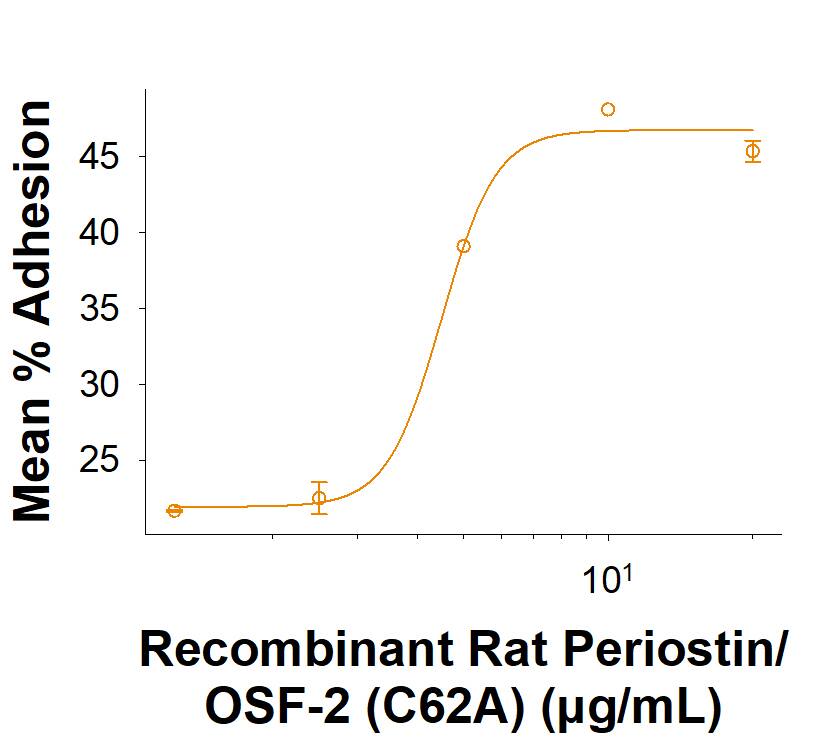Recombinant Rat Periostin/OSF-2 (C62A) His-tag Protein, CF
R&D Systems, part of Bio-Techne | Catalog # 11253-F2

Key Product Details
Product Specifications
Source
Human embryonic kidney cell, HEK293-derived rat Periostin/OSF-2 protein
Asn24-Ser800 (Cys62Ala), with a C-terminal 6-His tag
Asn24-Ser800 (Cys62Ala), with a C-terminal 6-His tag
Purity
>95%, by SDS-PAGE visualized with Silver Staining and quantitative densitometry by Coomassie® Blue Staining.
Endotoxin Level
<0.10 EU per 1 μg of the protein by the LAL method.
N-terminal Sequence Analysis
Asn24
Predicted Molecular Mass
87 kDa
SDS-PAGE
67-92 kDa, under reducing conditions.
Activity
Measured by its ability to induce adhesion of ATDC5 mouse chondrogenic cells.
The ED50 for this effect is 1.00-9.00 μg/mL.
The ED50 for this effect is 1.00-9.00 μg/mL.
Scientific Data Images for Recombinant Rat Periostin/OSF-2 (C62A) His-tag Protein, CF
Recombinant Rat Periostin/OSF-2 (C62A) His-tag Protein Bioactivity.
Recombinant Rat Periostin/OSF-2 (C62A) His-tag Protein (Catalog # 11253-F2) supports the adhesion of ATDC5 mouse chondrogenic cells. The ED50 for this effect is 1.00-9.00 μg/mL.Recombinant Rat Periostin/OSF-2 (C62A) His-tag Protein SDS-PAGE.
2 μg/lane of Recombinant Rat Periostin/OSF-2 (C62A) His-tag Protein (Catalog # 11253-F2) was resolved with SDS-PAGE under reducing (R) and non-reducing (NR) conditions and visualized by Coomassie® Blue staining, showing bands at 67-92 kDa.Formulation, Preparation and Storage
11253-F2
| Formulation | Lyophilized from a 0.2 μm filtered solution in PBS with Trehalose. |
| Reconstitution | Reconstitute at 500 μg/mL in PBS. |
| Shipping | The product is shipped at ambient temperature. Upon receipt, store it immediately at the temperature recommended below. |
| Stability & Storage | Use a manual defrost freezer and avoid repeated freeze-thaw cycles.
|
Background: Periostin/OSF-2
References
- Liu, A.Y. et al. (2014) Matrix Biol. 37:150.
- Gillan, L. et al. (2002) Cancer Res. 62:5358.
- Takeshita, S. et al. (1993) Biochem. J. 294:271.
- Kruzynska-Frejtag, A. et al. (2004) Dev. Dyn. 229:857.
- Lindner, V. et al. (2005) Arterioscler. Thromb. Vasc. Biol. 25:77.
- Horiuchi, K. et al. (1999) J. Bone Miner. Res. 14:1239.
- Li, G. et al. (2006) Atherosclerosis 188:292.
- Shao, R. et al. (2004) Mol. Cell. Biol. 24:3992.
- Yan, W. and R. Shao (2006) J. Biol. Chem. 281:19700.
- Erkan, M. et al. (2007) Gastroenterology 132:1447.
- Norris, R.A. et al. (2007) J. Cell. Biochem. 101:695.
- Kudo, Y. et al. (2012) PLoS One 7:e44488.
- Snider, P. et al. (2008) Circ. Res. 102:752.
- Kuhn, B. et al. (2007) Nat. Med. 13:962.
- Blanchard, C. et al. (2008) Mucosal Immunol. 1:289.
- Sehra, S. et al. (2011) J. Immunol. 186:4959.
Long Name
Osteoblast Specific Factor 2
Alternate Names
Fasciclin I-like, OSF-2, OSF2, POSTN, TRIF52
Gene Symbol
POSTN
UniProt
Additional Periostin/OSF-2 Products
Product Documents for Recombinant Rat Periostin/OSF-2 (C62A) His-tag Protein, CF
Product Specific Notices for Recombinant Rat Periostin/OSF-2 (C62A) His-tag Protein, CF
For research use only
